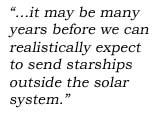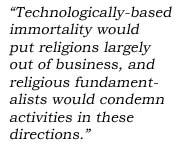Trajectories to the Heavens
William Sims Bainbridge, Ph.D.
Page 3 of 6
Quite apart from satisfying the technical requirements, interstellar transmission of personalities must satisfy the desires of living, human beings. Transmitting low-fidelity data about a person toward the stars helps commit that individual to the wider movement needed to bring the chances of full success to one hundred percent. I believe that every step in the process of developing means for personality transfer across the  galaxy must serve multiple motives. Personality capture can immediately return to the individual psychological analyses that help the person understand his or her own nature. Even a low-fidelity transmission, with low probability of reception, announces that the individual belongs to the future and deserves special recognition as someone who is working to build an interstellar culture. People who have been transmitted become part of a new social order, allied with each other and therefore belonging to a social community that may come to serve many positive functions for its members. As their bits of data are riding the radio waves to the stars, they can begin to build an interplanetary society closer to home.
galaxy must serve multiple motives. Personality capture can immediately return to the individual psychological analyses that help the person understand his or her own nature. Even a low-fidelity transmission, with low probability of reception, announces that the individual belongs to the future and deserves special recognition as someone who is working to build an interstellar culture. People who have been transmitted become part of a new social order, allied with each other and therefore belonging to a social community that may come to serve many positive functions for its members. As their bits of data are riding the radio waves to the stars, they can begin to build an interplanetary society closer to home.
The Starbase Concept
While we can begin to transmit radio signals today, it may be many years before we can realistically expect to send starships outside the solar system. However, it is not too early to begin developing the necessary support technologies, and personalities archived now can be included in voyages launched  decades or even centuries hence. In a book published by NASA in 2002, I wrote:
"We have the technology, already today, to begin archiving human personalities at low fidelity within what I call Starbase, a database destined eventually to be transported to the stars. To gain entry to Starbase, a person must contribute significantly in some way to the creation of interstellar civilization. One way is to help develop technologies for archiving and reanimating human personalities at ever higher fidelity. Another is to work toward the establishment of small human colonies, first on the Moon and Mars, where Starbase can be headquartered and where serious work on reanimation can begin. When the time comes for the first interstellar expeditions, they will be carried out not by biologically-based humans in their first brief lifetimes, but by eternal Starbase modules incorporating the archived but active personalities of the crew and colonists. At the destination, the crew will not waste its time terraforming planets, but will adapt the colonist into whatever form (biological, robot, cyborg) can thrive in the alien environment. Subsequent waves of colonists can be sent as radioed datafiles, in a technically feasible version of the old science fiction dream of teleportation." (Bainbridge, 2002a: 61-62)
decades or even centuries hence. In a book published by NASA in 2002, I wrote:
"We have the technology, already today, to begin archiving human personalities at low fidelity within what I call Starbase, a database destined eventually to be transported to the stars. To gain entry to Starbase, a person must contribute significantly in some way to the creation of interstellar civilization. One way is to help develop technologies for archiving and reanimating human personalities at ever higher fidelity. Another is to work toward the establishment of small human colonies, first on the Moon and Mars, where Starbase can be headquartered and where serious work on reanimation can begin. When the time comes for the first interstellar expeditions, they will be carried out not by biologically-based humans in their first brief lifetimes, but by eternal Starbase modules incorporating the archived but active personalities of the crew and colonists. At the destination, the crew will not waste its time terraforming planets, but will adapt the colonist into whatever form (biological, robot, cyborg) can thrive in the alien environment. Subsequent waves of colonists can be sent as radioed datafiles, in a technically feasible version of the old science fiction dream of teleportation." (Bainbridge, 2002a: 61-62)
This quotation contains much information. Notice that Starbase is built on a moral contract that obligates future generations to preserve and reanimate the personalities of the individuals who contributed to the development of the technologies and social institutions required to create Starbases and send them out into the galaxy. Note, too, that the scenario imagines that colonization of the solar system is a necessary prerequisite to interstellar flight. Most obviously, technology developed to enable colonization of Mars could readily be adapted to colonization of planets circling other stars, in areas as diverse as low-cost space propulsion, exploitation of extraterrestrial resources, and long-term protection against such hazards as hard vacuum [1] and ionizing radiation.[2] There is another reason why Starbase would need to be created elsewhere in the solar system, rather less technical and more distressing.
While recognizing that I could be wrong, I have expressed great concern that terrestrial religious and political movements  would attempt to block the development of immortality technologies and Starbase itself (Bainbridge, 2005a). Technologically-based immortality would put religions largely out of business, and religious fundamentalists would condemn activities in these directions. Already we see political opposition to cloning and transhumanism, much of it religiously based. Back in 1993 I predicted that mobs of fanatics would frequently break into personality archives to erase their contents, a form of murder I call infocide because it kills people in their pure form, which is information (Bainbridge, 1993). Some will argue that cybernetic immortality should be banned from the Earth, in order to ensure that generations of unborn children will not be crowded out of existence by immortal elders, who would be dependent upon the economy even if they were not present in biological bodies. Perhaps the only way to establish a lasting truce between fundamentalist reactionaries and evolutionary progressives would be to agree that immortality of all kinds, including cyberimmortality, would be excluded from Earth but encouraged throughout the solar system and galaxy.
would attempt to block the development of immortality technologies and Starbase itself (Bainbridge, 2005a). Technologically-based immortality would put religions largely out of business, and religious fundamentalists would condemn activities in these directions. Already we see political opposition to cloning and transhumanism, much of it religiously based. Back in 1993 I predicted that mobs of fanatics would frequently break into personality archives to erase their contents, a form of murder I call infocide because it kills people in their pure form, which is information (Bainbridge, 1993). Some will argue that cybernetic immortality should be banned from the Earth, in order to ensure that generations of unborn children will not be crowded out of existence by immortal elders, who would be dependent upon the economy even if they were not present in biological bodies. Perhaps the only way to establish a lasting truce between fundamentalist reactionaries and evolutionary progressives would be to agree that immortality of all kinds, including cyberimmortality, would be excluded from Earth but encouraged throughout the solar system and galaxy.
Interplanetary space is also a good location to build the infrastructure for interstellar communication and travel. It has been suggested that the ideal place to build really large radio telescopes to hunt for extraterrestrial signals would be across craters on the far side of the Moon. I tend to have a different vision: 100-kilometer wide “dish” antennas made out of metal-coated plastic sheeting, stationed far enough out in the solar system to reduce the distorting effect of the solar wind, perhaps keeping their parabolic shape by a combination of rotation, gentle acceleration, and elastic rigging. Long-duration missions in the outer solar system would be good preparation for the exceedingly long duration of interstellar missions.
Three decades ago, the British Interplanetary Society [3] published a reasonable design study, Project Daedalus, [4] for an interstellar probe that could use nuclear fusion power to achieve a velocity of 12 percent of the speed of light. At that rather impressive speed, it would still take an entire human lifetime to reach stars at a distance of 10 light years, and the design made no provision for slowing down again at the destination star. If the general principles of the BIS study are valid, then interstellar ships traveling at roughly five percent of the speed of light are feasible. This already means a century to reach the nearest star, and two or more centuries to reach many stars that have a good chance of harboring colonizable planets or moons. Given how long the shortest feasible voyages would be, it may be better to back off to even lower velocities, investing not so much in speed as in durability and in sending a great number of ships to different destinations. Many writers have suggested self-reproducing probes that would construct multiple copies of themselves at the nearest stars, and send them to other stars farther out, with their eventual offspring attaining the far edge of the galaxy.Footnotes (Additional references on Page 6)
1. Hard vacuum - A vacuum that approximates the vacuum of space.
http://www.daviddarling.info/encyclopedia/H/hard_vacuum.html August 14, 2007 3:23PM EST
2. Ionizing – 1. to separate or change into ions; 2. to produce ions in; 3. to become changed into the form of ions, as by dissolving.
http://dictionary.reference.com/browse/ionizing August 14, 2007 3:26PM EST
3. British Interplanetary Society - serves both space flight professionals and those with a general interest in space flight and astronautics. The Society has a worldwide membership, and is actively devoted to supporting forward looking policies and visionary thinking towards the advancement of space flight through its publications, symposia, meetings and other events.
http://www.bis-spaceflight.com/ August 14, 2007 3:28PM EST
Project Daedalus - a study conducted between 1973 and 1978 by the British Interplanetary Society to design a plausible interstellar unmanned spacecraft. A dozen scientists and engineers led by Alan Bond worked on the project, and settled on proposing a fusion rocket as its drive.
http://en.wikipedia.org/wiki/Project_Daedalus August 14, 2007 3:31PM EST